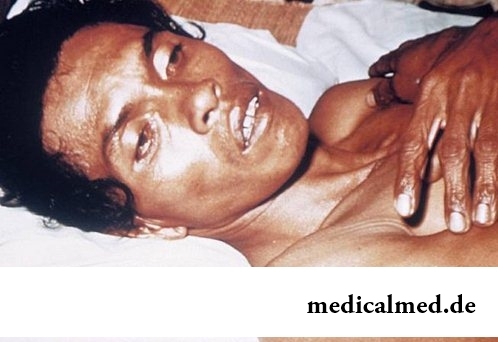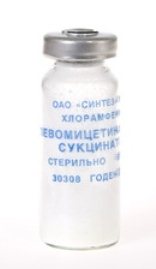





Cholera
Short characteristic of a disease

Cholera belongs to the category of acute intestinal diseases. Cholera begins to develop at hit in an organism of the water or food infected with bacteria from the Vibrio cholerae family. The disease has a short incubation interval (it is quite often shown already within a day after infection), is followed by unpleasant symptoms, in the absence of treatment can lead to a lethal outcome. So serious consequences are connected with the fact that the causative agent of cholera produces enterotoxin which causes numerous disturbances in work of digestive tract and leads to severe dehydration of an organism because of ongoing diarrhea. Quite often cholera provokes severe vomiting during which the water salt metabolism is also broken.
Cholera is among quarantine infections. At boiling causative agents of cholera perish literally within several seconds, but in conditions, favorable for themselves they breed extremely in high gear. Get to external environment of a bacterium of cholera with excrements and emetic mass of the sick person, and then strike healthy people in the water, food, contact and household or mixed way. The high susceptibility to cholera became the reason of large-scale epidemics more than once. It is possible to bring into qualities of an example 1992 when insufficient and inefficient prevention of cholera led to emergence more than 100 000 sick people in the Southern India and Bengal. In general, for years of existence a civilization this infection claimed millions of the lives and continues to collect regularly the terrible harvest in the countries of Africa and Southeast Asia. The difficult epidemic situation in these regions is not accidental. The matter is that cholera which symptoms are usually shown after the use of the infected water or food develops most intensively in those places where there are problems with disinfecting of fresh water and timely medical care.
How cholera gets into a human body?
At cholera epidemics excrement of the infected people become a source of bacteria. Most often cholera embryos are found in coastal waters and salty water from where they get into city sewerages and other sources of water supply. Let's notice also that the accidental contact with the sick person cholera will not lead to infection as the disease is not transmitted directly. At the same time, the causative agent of cholera can get easily into an organism in the course of sharing of personal care products therefore observance of elementary precautionary measures nevertheless is necessary.
Cholera symptoms
At once we will note that Symptoms of cholera are very diverse. In certain cases at the diagnosis cholera treatment at all is not required (situations with a so-called asymptomatic carriage belong here) while at other people cholera leads to emergence of the most serious conditions and a lethal outcome.
The incubation interval seldom proceeds more than 5-6 days. The onset of the illness is always acute, at the same time cholera symptoms are expressed:
- the diarrhea which amplifies in night and morning hours – a chair at the same time watery has no unpleasant smell, over time takes a form of "rice broth";
- the plentiful gushing forth vomiting;
- disturbance of activity of the main systems of an organism which intensity depends on dehydration degree;
- lack of appetite;
- decrease in body weight;
- constant thirst.
If there are suspicions that at the person cholera develops, diagnosis, among other, is carried out on the basis of a clinical picture of development of a disease. Specialists allocate 4 degrees of cholera:
- The I degree – dehydration is expressed poorly;
- The II degree – at patients is noted falling of liquid to 6% of body weight, acceleration of SOE, reduction of number of erythrocytes. Patients complain of dizziness, dryness in a mouth, thirst, sharp weakness. Besides, at them fingers of hands become blue, convulsive twitchings of muscles, a voice osiplost appear;
- The III degree – at heavy cholera, treatment assumes constants control of arterial pressure and body temperature as the sudden collapse of the vital systems is quite possible. Loss of liquid reaches 9% of body weight, at patients release of urine can stop completely. In blood of sick people decrease in potassium concentration and chlorine is noted;
- The IV degree - critical loss of liquid, development of a condition of prostration, shock. At patients features are pointed, dark circles around eyes appear, skin gets a cyanotic shade and becomes sticky to the touch. Cardiac sounds are muffled, sharp falling of arterial pressure, decrease in body temperature to 34 degrees is noted. Such cholera which symptoms demonstrate numerous failures in work of the main systems quite often comes to an end with the death of the patient.
If in time not to see a doctor, then even slight cholera can lead to numerous complications: to abscesses, pneumonia, phlegmons, erysipelatous inflammations and phlebitis. For this reason you have to monitor attentively emergence of alarming symptoms of cholera after the use of food or water and to address immediately to medical institutions for statement of the exact diagnosis.
Diagnosis of cholera
At diagnosis of cholera recognition of an infection is made on the basis of a characteristic epidanamnez and a clinical picture. For confirmation of cholera bacteriological researches of excrements, gastric contents and emetic masses are used. Besides, to patients appoint laboratory physical and chemical blood tests.
Treatment of cholera

At suspicions on existence of an infection patients are subject to hospitalization. At strong indications of dehydration rehydration therapy is carried out immediately in those volumes which are defined by a condition of the patient. Peroral administration of liquid means usually recovery actions. Also she can be brought in a stomach through a stylet if the person is not able to drink independently. Within an hour sick cholera has to use not less than 1-1,5 l. liquids. If the disease is followed by severe vomiting, then treatment of cholera assumes obligatory administration of half-ionic solutions in blood.
After normalization of a condition of the patient correction of losses continues. Water-salt therapy is finished only after excrements accept normal fecal character, and the amount of urine will exceed the volume of fecal masses. After the termination of vomiting at treatment of cholera tetracycline or levomycetinum intravenously is appointed. The course of treatment of cholera lasts for 5 days with 6-hour cycles. At the timely address to the doctor and the adequate help cholera is treated successfully without any serious complications.
Prevention of cholera consists in observance of sanitary and hygienic rules, careful washing of products, respect for the established technological norms at catering establishments. Also we strongly recommend you to refuse at prevention of cholera the use of unboiled water from under the crane.
The 74-year-old resident of Australia James Harrison became blood donor about 1000 times. It has a rare blood group which antibodies help to survive the newborn with a severe form of anemia. Thus, the Australian saved about two million children.

Dark circles (bruises) under eyes – a shortcoming with most of which often fight against the help of cosmetics (proofreaders, salons...
Section: Articles about health
No, probably, the person who would not have cold. Cold, cough, a headache – these symptoms are known to everyone. The peak of catarrhal diseases is the share of fall. SARS already came to schools and kindergartens, flu slowly makes the way to the cities, in a word, з...
Section: Articles about health
Life does not indulge the modern woman special emotional comfort and carelessness. The fatigue, troubles at work, misunderstanding in a family and various illnesses immediately affect a condition of hair and skin. And there is a wish to look safe and attractive so! Substantially competently picked up diet can improve situation....
Section: Articles about health
The metabolism at each person proceeds in own way. However dependence between the speed of this process and disposal from superfluous in...
Section: Articles about health
Each person knows that fervescence is an illness sign. However too low temperature (hypothermia), especially also can demonstrate existence of diseases when it is observed long enough. Such state is dangerous those...
Section: Articles about health
When overcomes feeling of hunger, and an opportunity to have dinner fully is absent, having a snack − the meals, small on volume, stabilizing sugar level in blood comes to the rescue. The relation of nutritionists to having a snack more often negative, but only because as snack people choose the most caloric products with the increased amount of "bystry" carbohydrates: cookies, rolls, chips, candies. Nevertheless, the advantage of having a snack is obvious to weight loss: the person avoids strong feeling of hunger...
Section: Articles about health
The main role in development of a peptic ulcer of a stomach and duodenum the bacterium Helikobakter plays pilor. Activity and Wuxi...
Section: Articles about health
Weakness of an ankle joint – very widespread problem. Its existence is demonstrated by tendency to a podvorachivaniye of legs when walking on heels, frequent painful sprains, pain on average and anonymous toes even after small nagruzo...
Section: Articles about health
Sometimes it seems that modern society was divided into two camps: representatives of the first are sure that only the woman has to be responsible for contraception, representatives of the second, respectively, are sure that it is destiny of men. Meanwhile the question of contraception has very many aspects – both psychological, and legal and, of course, medical....
Section: Articles about health
Stroke (acute disorder of cerebral circulation) – one of the most widespread neurologic diseases. Annually in the world...
Section: Articles about health
Partial and the more so full loss of hearing significantly reduces quality of life. Difficulties with communication lead to loneliness and isolation. The person who badly hears experiences difficulties with social and professional implementation, quite often has problems in...
Section: Articles about health
The state of health of the person in many respects depends on chemical composition of biological liquids of an organism. Specialists consider that PH value of these solutions has to be in range of 7,35-7, 45. The deviation in the smaller party (so-called "acidulation") is fraught with development of many heavy illnesses, failures in work of immune system, decrease in working capacity and deterioration of life. To avoid serious fluctuations of acidity of internal liquids it is necessary to adhere разумног...
Section: Articles about health
Today about 30 diseases, sexually transmitted are known. To wide circulation of these illnesses extremely with...
Section: Articles about health
Separate food - the system of meal based on digestion physiology which is carried to improvement methods. According to nutritionists, the separate use of the carbohydrate and proteinaceous products demanding different conditions of assimilation helps to get rid from Bol...
Section: Articles about health
The nature does not stand stagnation and monotony. It is known that tissues of a human body atrophy if do not receive necessary loadings. It fully belongs also to a cerebral cortex: when it is not given full-time job, it begins to function worse. As a result memory decreases, the person becomes less bright, acquires information more slowly, hardly switches from one thought to another. There are problems at work, difficulties with communication and career development. These it is unpleasant...
Section: Articles about health
The problem of diagnosis was and remains to one of the most important in medicine. From that, the reason недо will be how precisely defined...
Section: Articles about health
A lot of things depend on a condition of a backbone in a human body, a backbone - not only a support for a body, it also a receptacle for a spinal cord, that is why malfunctions with a backbone are so dangerous. To treat rachis diseases very difficult and long...
Section: Articles about health
Helminthosis is one of the most widespread diseases. Statistically, any species of helminths infected every third inhabitant of the planet. Most of specialists even consider these data strongly underestimated: some uninvited "cohabitants" do not cause the carriers serious troubles, and patients just do not see doctors. The situation is aggravated also with the fact that people know about specifics of similar illnesses very little. At many presence of worms is strong ассоциир...
Section: Articles about health
Each person supports all life a SARS about 200 times. The peak of incidence falls on cold season, but to get sick from temperatures...
Section: Articles about health
Any person who faced a disease knows that treatment costs expensive. It belongs also to consultations of qualified specialists, and to the diagnostic procedures which are not included in the list of obligatory medical services. Question of cost of medicinal Wednesday...
Section: Articles about health
The trophic ulcer is not an independent disease. This heavy complication arising owing to a thermal injury (a burn or a frostbite), chronic pathologies of arteries or veins of the lower extremities, a diabetes mellitus, and also some defeats of connecting fabric, absorbent vessels, skin or nervous trunks. Pathology is shown in the form of not healing wound located on the internal surface of a shin, a foot sole, a heel or toes....
Section: Articles about health
From the failure of work of immune system which is shown in the form of an allergy, statistically, more than 40% of the population of the globe suffer. In большинс...
Section: Articles about health
On the head of the person about one million hair follicles, or as they are called still, hair bulbs are located. At the time of the birth most of them is in the "sleeping" state, but within several weeks follicles become more active, and from them begin р...
Section: Articles about health
History of mankind contains several tens of epidemics whose emergence was compared by eyewitnesses and historians to doomsday. The most terrible of them claimed the lives of millions of people, having made even the whole people to the person of the earth. What they − the diseases striking terror? Whether it managed to the person to find treatment, or he is still powerless before forces of nature?...
Section: Articles about health
Each of us faces from time to time that other people need the immediate help. We react to it on-raznomu:...
Section: Articles about health
With age in a human body harmful substances collect. We receive them with food and water, at inhalation of the contaminated air, reception of medicines, use of household chemicals and cosmetics. A considerable part of toxins accumulates in a liver, osnovno...
Section: Articles about health
For most of the working people the problem of having a snack is particularly acute enough. Sooner or later there is a question: what can be eaten quickly between a breakfast and a lunch or a lunch and leaving from service so that to receive necessary power feed, but not to overload an organism with harmful components or excess calories? We bring to your attention the list of products which quite conform to these requirements....
Section: Articles about health
